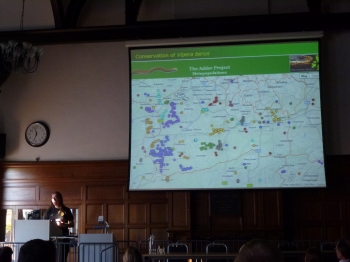tThe adder, Britain's only venomous snake, is in crisis. This is the conclusion drawn by a group of reptile experts and conservationists who attended a conference on the latest research on adders, including reports about its status in this country.
The meeting at Greenwich University in Chatham, Kent, on Saturday 19 November painted a bleak picture of the snake's likely future.
Adder numbers are thought to be falling, and at the end of the conference the more than a hundred participants unanimously passed a motion stating that the adder is in more urgent need of new conservation efforts than any other reptile or amphibian species in Britain.
Said Gail Austen-Price of the Kent Reptile and Amphibian Group which arranged the conference: "There is a regional meeting of amphibian and reptile groups in London and the South East every year, but this year we decided to hold a meeting about adders because our own experience suggested that their conservation is a matter of concern. We were proved right. This conference has set a milestone by announcing that the adder's plight is reaching a critical point, and now is the time for government bodies and conservation organisations to take note."
Reptile ecologist Dr Chris Gleed-Owen, who chaired the final session, explained: "Adders are widespread but numbers are dwindling and the snake is now extinct in some counties such as Nottinghamshire and Warwickshire. In many areas remaining adder populations have become very small because of habitat loss, and are very vulnerable to inbreeding as well as any further damage to habitat.
"Some people still persecute adders even though they are protected by law and only bite humans in self-defence when they can't escape. But the main problem is that adders are often given a low priority in management plans even in nature reserves and protected landscapes. For instance scrub clearance may be carried out to restore chalk grassland without considering whether this may harm hibernating adders.
"Sometimes land managers don't even know that adders are present, but even when they do totally inappropriate actions may be carried out. One site I was studying was cut with a flail killing at least two adders out of a population of 10 adults."
One of the main threats to adders is the accidental destruction of their winter hibernation refuges. Dr Gleed-Owen pointed out that adders often hibernate communally in mammal burrows or under tree roots. Damage to these sites while the snakes are there risks killing an entire population, but even when they are absent may force the snakes to disperse into less suitable habitat.

The meeting was told that ARG UK, the national umbrella organisation for amphibian and reptile groups, now plans to set up a national register of hibernation sites, to alert local authorities and other countryside managers of these crucial locations. It is also setting up a website for a flagship survey project called Make the Adder Count, where volunteers monitor adder numbers at their local sites.
Adders are famous for dancing (true, actually a ritualised wrestling match between males competing for a female) and for swallowing their young (false), but experts admit that they suffer from a poor public image.
"We need a battle plan to raise awareness and appreciation," Dr Gleed-Owen said. "It would be tragic if this iconic animal, steeped in history, folklore and literature, were to disappear."
The adder (scientific name: Vipera berus) is a small snake, reaching about two feet (60cm) long. It is typically brown or grey, with a distinctive dark zigzag running the entire length of its body from head to tail.
Adders generally live in heathland, moorland, sand dunes, forest edges and other relatively wild places. They tend to avoid human habitation and highly disturbed areas such as arable farmland.
If approached an adder will normally retreat, but if it feels threatened and cornered it will hiss and may strike. The best thing to do is stand well back from a suspected adder, and let it escape unharmed.
Many people mistake other species for adders, especially grass snakes and slow-worms which are common in gardens and allotments. Both are harmless, and neither has the adder's distinctive zigzag marking along its back.
Adders are venomous (they deliver venom through their teeth to kill prey or defend themselves). Bites are fairly frequent, but they rarely kill humans. The last death in Britain was in 1975.
Loss and fragmentation of adder habitats, and unsympathetic land management are believed to be the causes of much local extinction. Persecution is also a problem, despite the adder being legally protected.
The adder is protected in Britain under Schedule 5 (Section 9) of the Wildlife and Countryside Act 1981 (as amended), which prohibits killing and injury.

